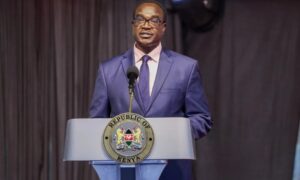Nairobi, Kenya – Cabinet Secretary for the National Treasury, Hon John Mbadi Ng’ongo, has claimed that out of 400 casualties recorded during Wednesday’s Gen Z protest, 300 were police officers. The revelation has sparked heated debate, with critics questioning the accuracy of the figures and accusing the government of downplaying civilian injuries.
The demonstrations, which turned violent in Nairobi CBD and other parts of the country, were a continuation of youth-led movements against police brutality and government repression. The protests were triggered by the recent killing of Albert Ojwang’, a government critic who died in police custody under unclear circumstances.
Mbadi’s Controversial Statement
In a post on X (formerly Twitter) on Friday, John Mbadi, the Treasurer and prominent government official, accused Kenyan media of bias, alleging that outlets failed to highlight police injuries while emphasizing civilian casualties.
“Out of the 400 casualties of Wednesday, 300 were police officers, 100 were civilians! But Githeri media still maintains that it is the police who attacked the civilians. Sorry state,” Mbadi wrote.
His remarks were met with skepticism, with many questioning the credibility of the numbers. Winfred Nderitu, a social commentator, challenged Mbadi’s claim, stating:
“Assuming the correctness of your figures (i.e., three out of every four casualties were police officers), one would also expect that of the 19 people killed, 15 were police officers… But I’m not an FCPA.”
Public Backlash and Police Accountability
The statement intensified public anger, with many Kenyans accusing the government of attempting to justify police brutality. Social media users, including Mukada Wambani, criticized the security forces, warning:
“The police declared war. They should know that they are a minority in a country of 50 million people. Now it is just the beginning.”
Human rights groups have documented widespread violence during the Kenya protest, including live ammunition use, tear gas, and beatings. The Gen Z demonstrators, who have been at the forefront of anti-government rallies since the 2024 Financial Bill protests, accuse police of excessive force.
A Repeat of History?
The latest protest in Kenya mirrors the deadly 2024 demonstrations when youths took to the streets to oppose tax hikes under the Financial Bill 2024/2025. Dozens were killed, and hundreds injured in clashes that drew international condemnation.
This week’s unrest was largely peaceful until police engaged protesters, leading to running battles in Nairobi and other cities. Businesses shut down, and public transport was disrupted as demonstrators demanded justice for Ojwang’ and an end to extrajudicial killings.
Government Response and Rising Tensions
The government has yet to issue an official casualty breakdown, but independent observers dispute Mbadi’s figures. The Kenya National Commission on Human Rights (KNCHR) reported that most injuries were civilian, with at least 19 fatalities—none confirmed to be police officers.
Analysts warn that the continued crackdown on Gen Z protesters could escalate tensions further. The movement, largely organized online, has gained momentum, with young Kenyans demanding systemic reforms, accountability, and an end to state-sanctioned violence.
What Next for Kenya?
As pressure mounts on President William Ruto’s administration, questions linger over how the government will address the crisis. Calls for dialogue have been dismissed by protesters, who accuse leaders like Mbadi John Ng’ongo of insensitivity.
With another wave of demonstrations planned, Kenya faces a critical moment. Will the government heed the calls for reform, or will the cycle of protest and repression continue?
For now, the streets remain a battleground, and the voices of Gen Z grow louder—demanding justice, accountability, and a future free from fear.





















